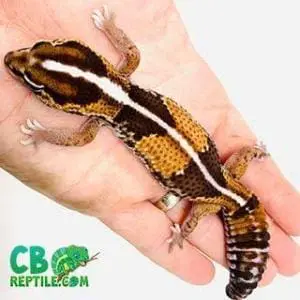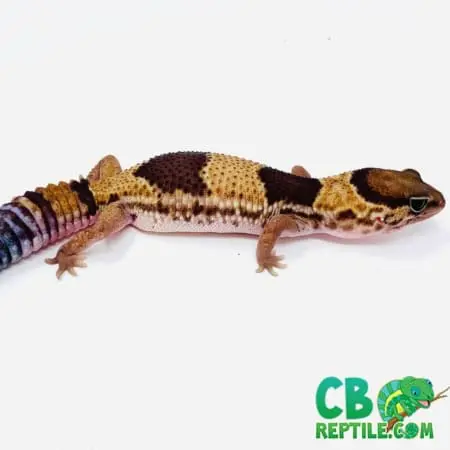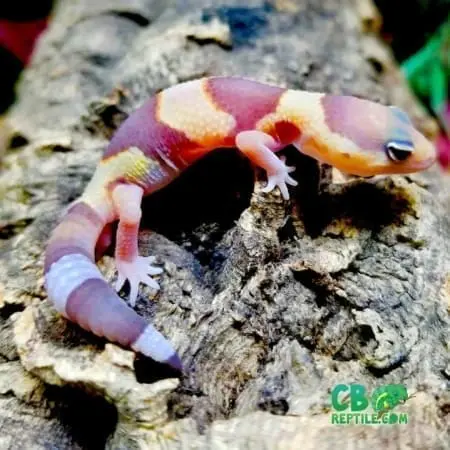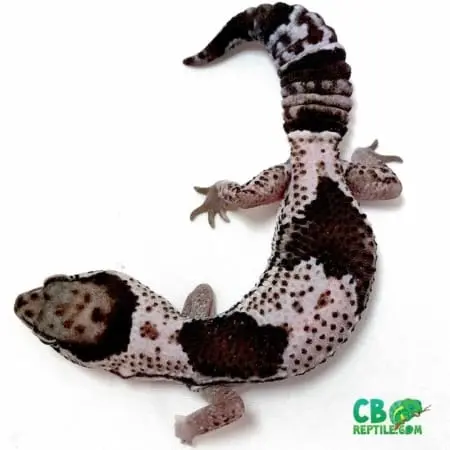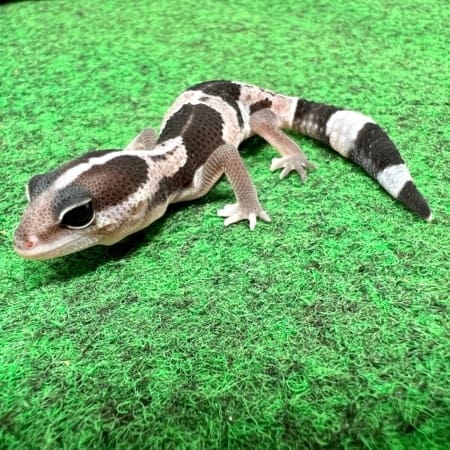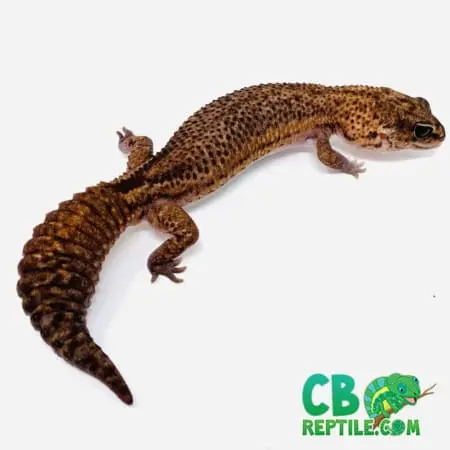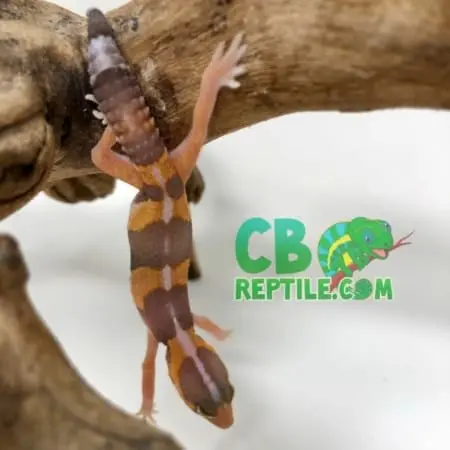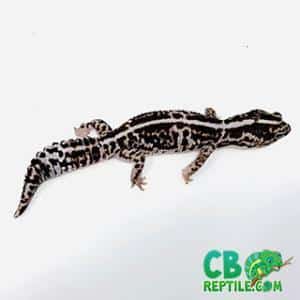African fat tailed gecko size
The African fat–tailed gecko is typically around 7-9 inches. Males are full grown around 55 grams and 8-9.5 inches. Females are smaller, growing to 50-55 grams but only 8 inches in overall head to tail length. There are always exceptions to the sizing rule of thumb, of course. Having a larger female fat tail usually does equate to larger, healthier eggs and offspring. Fat tailed geckos size are often the result of captive breeding, and are typically healthier and larger than wild caught specimens. Here at CB Reptile, all of our baby, juvenile and adult African fat tail geckos for sale are captive bred!
African Fat Tailed Gecko Care
Before purchasing your new baby african fat tailed gecko for sale, or any gecko for sale online, first locate a reputable CAPTIVE BRED African Fat Tailed Gecko breeder. and then start your research to learn proper African fat tailed gecko care, including the african fat tailed gecko diet, african fat tailed gecko habitat setup and more.
Below you will find detailed information on fat tail gecko care provided by our biologist including the following:
- fat tail gecko breeders
- fat tail gecko care sheet
- African fat tailed geckos for sale
- baby fat tail gecko
- African fat tailed gecko diet
- Fat tailed gecko habitat
- How to pick up a fat tail gecko
- Handling your baby fat tail
- African fat tail gecko size
- Fat tailed gecko lifespan
- African fat tail gecko substrate
- Fat tail gecko humidity
- Fat tail gecko temperature
- African fat tail gecko UVB light
- Fat tailed gecko morphs
- African fat tailed gecko pictures
- African fat tailed gecko
- Patterned fat tail gecko
- Patternless fat tailed gecko
- Whiteout fat tailed gecko
- Striped African fat tailed gecko
- Oreo fat tail gecko
Fat tailed gecko care tips
The African Fat Tailed Gecko, once rare is becoming more of the most sought after pet geckos for sale. Although not as popular as the more common Leopard Gecko, African fat tails are gaining popularity. Why are they not as popular as other species of pet gecko? Well, partially because they are rather difficult to breed when compared to leopard gecko breeders. However, if you are seeking a docile, cute and easy to care for pet gecko for sale, look no further than the beautiful African fat tail gecko. Leopard geckos for sale are very similar to the Fat tail gecko, however the fat tail is more relaxed. Leopard geckos offer more color, known as leopard gecko color morphs as well.
In this article, we will look at the care and feeding requirements of the Fat Tailed Gecko. Before you purchase your new baby fat tail gecko for sale, we recommend reviewing all of the care guidelines provided here. Caring for a new baby African Fat-tailed gecko for sale is easy, so long as you invest the time to set up your fat tail gecko habitat properly. Be sure to follow the African fat tail gecko diet guidelines as well.
How many fat tail geckos per habitat?
The Fat-Tailed Gecko can be kept either alone or in pairs or groups. Typically you are looking at keeping males alone, and female African fat tailed geckos for sale together in groups up to 4 per habitat. Fat tails are calm, and small in size, and as they are not among the largest of the lizard species.
For these reasons, AFT as we call them do not require an extremely larger habitat, tank, or vivarium. To keep one or two Fat Tailed Geckos, look at getting a tank that is a minimum of 12″ long by 12″ and deep. To keep more than two together, increase the length of the tank by 45cm per additional lizard. Learning proper fat tail gecko care is key.
Fat tail habitat Decor, fat tail gecko substrate and living environment
The Fat-Tailed Gecko hails from hot, humid parts of the world, and it is important to mimic their natural environment as far as is possible within the domestic vivarium. For their substrate, the soil is the preferred medium as this retains moisture without getting soggy, and enables the natural burrowing behavior of the species.
While it is possible to use a dry substrate, you will need to provide a moisture box for your pet if you wish to do so. The Fat-Tailed Gecko requires a slightly higher humidity level than the Leopard Gecko, which is important to bear in mind if you have kept other gecko species before.
Decorating the African Fat Tail gecko habitat
Depending on the look and feel you are going for, the fat tail terrarium, or habitat should be decorated with a range things. Some decor can be rocks, pieces of wood, even artificial plants to provide hiding places for your lizards. Always be careful when you are placing decor items within the habitat.
Fat tailed gecko care – habitat decorations
It is always a good idea to add the items before adding the substrate to your habitat. Remember that African Fat Tail Geckos are very good at burrowing and digging. Because of this, they may dislodge ornaments that are not secured in the substrate.
Fat-tailed gecko care – Heating & temperature
As with all other reptile species, fat tailed geckos thermoregulate. Simply put, the African Fat-Tailed Gecko needs to be able to find a range of different temperature gradients within different parts of their tank or habitat. Also, this means that the temperature should not be the same across the whole fat tail habitat or enclosure.
The warmer end of the tank should fall between around 86-90 degrees Fahrenheit for daytime hours. Lastly the cool end should be between 74-84 degrees. Finally, for evenings and overnight time, the temperature should be more consistent, and fall between the 74-78 degrees range. This is important for both adults and breeding adults to properly be able to thermoregulate themselves.
What is the best way to provide heat to my African Fat tail gecko habitat?
There are a range of different options available to heat your vivarium, but the most widely used and preferred system for the Fat Tailed Gecko is by means of a ceramic heater, as this gives off plenty of heat at the warmer end of the vivarium without taking up a lot of valuable space. Other options include a heat lamp, or under-substrate heating mat.
Fat tail gecko lighting requirements
Like leopard geckos for sale, Fat tailed geckos do not require UVB light. So if you’re looking into fat tailed gecko lighting, consider using LED or something that may not give off heat, unless of course you’re relying on the light to also provide heat. Typically heat mats are used and put under one of the humid hide areas to maintain temperature.
Usually this allows there to be a temperature gradient if the other side of the geckos habitat is not heated. In their natural habitats, the African fat-tailed gecko is mostly nocturnal and will be most active after dusk until dawn. However, fat tails do venture out during the day, sometimes to regulate their body temperatures. A simple reptile-suitable heat lamp is fine to allow for this, or a heat mat. Remember, a Fat Tail Gecko does not have any special requirements such as reptile UVB lights, making them relatively easy to provide for.
Food and water for your Fat-Tailed Gecko
A source of clean, fresh water that is available at all times is vital for your gecko. Remember, fat tailed gecko hails from Western Africa, which benefits from high humidity levels. Always provide your fat tail shallow and wide water dish that can be easily cleaned. Trying to fin something like the reptirock sold here so they are not able to tip it over. Fat Tailed Gecko eats a range of different insects, but they mostly feed on crickets.
Mealworms for sale are great for your baby fat tailed geckos for sale if you are able to get them to eat them. It takes a while, but we feel it is well worth converting your fat tail gecko to a mealworm eater. From time to time, fat tail gecko breeders are able to even get fat tailed geckos to eat pre prepared foods.
Fat tailed gecko insects and food options
In terms of live food options for your fat tail, crickets, locusts, mealworms, and wax-worms are the ideal combination to feed, in order to meet your gecko’s nutritional requirements. Keep in mind that crickets are the easiest of all insects to feed, since they seem to go right after then. Live insects fed to your gecko should be as high in nutrients as possible. What does this means? It means dusting our insects as well as gut loading then.
Mealworms for sale
Here at CB we feed our gecko babies and adults our high quality live mealworms for sale. If you are looking to purchase a new baby fat tailed gecko, be sure to also pick up some real mealworms for sale. We absolutely guarantee you the best quality mealworms for sale in the country. Also, we offer subscriptions so you can get your live mealworms shipped to your door automatically, each week, or month. When dusting any insect, we recommend a 50/50 combo of both reptile calcium with D3, as well as a reptile multivitamin. Also be sure that your fat tail geckos are well-fed but also focus on gut loading and dusting their insects.
Handling an African fat tailed gecko
African fat tailed geckos are fairly docile and easy to handlem pet geckos for sale. Maybe the calmest of all species of pet geckos, the AFT as we call them are some of our favorite species of gecko for sale. Once your new baby, juvenile or adult fat tail is settled in, work on using the “scoop method” to gently push them onto your one hand, using your other / dominant hand. By doing this instead of picking them up, it allows them to remain calm and not feel threatened.
Any reptile, or gecko for that matter, will feel a bit anxious if picked up. Supporting your geckos entire body weight by gentling nudging it to your other hand is best. Basically, try your best to not have your fat tail gecko thinking you are picking it up. He or shee needs to rather feel as if they are simply walking onto your other hand.
Fat tailed gecko Lifespan
Well cared for African fat tail geckos, in captivity live the longest. In the wild it is believed that AFT live just about 10 years. In captivity, however, African fat tails can live up to 25 years! That is correct, if you are pondering “How does a fat tailed gecko live?” The answer is pretty damn long! They have a captive lifespan of 10–25 years. For this reason, we highly recommend looking into the fat tail gecko for sale as a pet reptile for beginners as well as experienced reptile enthusiasts.
Fat tail geckos have great appetites
Crickets will be the staple food of any young African fat tailed gecko. When young, baby Fat Tail Geckos will have a good appetite. Their metabolism is high, and for that reason they should be fed small insects daily. Once your African fat tailed gecko is mature, his or her feeding requirements will drop to 1-2 times per week. This is another reason fat tailed geckos are such an easy pet gecko to own! Once mature, fat tails do not need need additional food in order to grow. Remember, always dusting of your gecko’s live insect food with a calcium supplement cannot be ignored. Properly dusted and gut loaded insects will provide you a happy, and healthy African fat tailed gecko.
African Fat Tail Geckos
Fat Tail geckos for sale or African Fat Tail Geckos are some of the coolest and easy to handle and care for geckos for in the world. AFTS are getting more and more popular now that breeders like us have discovered many different Fat-Tailed Gecko morphs and are breeding some spectacular colored animals including Amelanistic, Tangerine, Zulu, Whiteout, Oreo fat tailed gecko, Zulu Fat tailed gecko, Zero and more. If you are searching for a fat tail gecko for sale near me, consider an AFT! A baby tat tail gecko is very similar to leopard geckos for sale in care and appearance.
Fat Tail gecko morphs for sale here at CB Reptile!
CB has the nicest fat tail gecko, including baby fat tail gecko, adult fat-tailed gecko, and juvenile fat tailed geckos for sale online. Also, as Fat tail gecko breeders, we offer many fat tail gecko morphs. Some gecko morphs include the popular and common fat-tailed gecko morphs for sale. The African Fat Tail gecko is one of our personal favorites. If you are interested in learning about proper African Fat Tail Gecko care, please click here.

